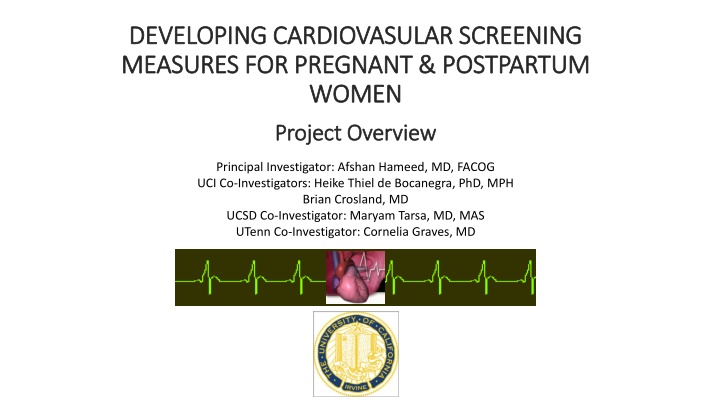Developing Cardiovascular Screening Measures for Pregnant and Postpartum Women Project
Cardiovascular disease (CVD) is a leading cause of maternal mortality in the US, with disparities in morbidity. Standardizing evaluation and triage is crucial. Preventability studies show a high potential for identifying at-risk cases. The CVD Toolkit aims to enhance awareness and readiness among healthcare providers, emphasizing prenatal and postpartum care settings.
Download Presentation

Please find below an Image/Link to download the presentation.
The content on the website is provided AS IS for your information and personal use only. It may not be sold, licensed, or shared on other websites without obtaining consent from the author.If you encounter any issues during the download, it is possible that the publisher has removed the file from their server.
You are allowed to download the files provided on this website for personal or commercial use, subject to the condition that they are used lawfully. All files are the property of their respective owners.
The content on the website is provided AS IS for your information and personal use only. It may not be sold, licensed, or shared on other websites without obtaining consent from the author.
E N D
Presentation Transcript
DEVELOPING CARDIOVASULAR SCREENING DEVELOPING CARDIOVASULAR SCREENING MEASURES FOR PREGNANT & POSTPARTUM MEASURES FOR PREGNANT & POSTPARTUM WOMEN WOMEN Project Overview Project Overview Principal Investigator: Afshan Hameed, MD, FACOG UCI Co-Investigators: Heike Thiel de Bocanegra, PhD, MPH Brian Crosland, MD UCSD Co-Investigator: Maryam Tarsa, MD, MAS UTenn Co-Investigator: Cornelia Graves, MD
Problem 1 Problem 1 Cardiovascular disease (CVD) among pregnant and postpartum women is the leading cause of maternal mortality in the US There are large racial/ethnic disparities in CVD-associated maternal morbidity and mortality Normal pregnancy may mimic CVD symptoms and diagnosis may be missed Need to standardize evaluation and triage of pregnant patients with potential CVD signs and symptoms, use of a standardized clinical decision making tool for women receiving prenatal and postpartum care
CA-PAMR Findings Preventability 2002-2006 24% of ALL CVD pregnancy-related deaths (and 31% of cardiomyopathy deaths) were determined to be potentially preventable A CMQCC pregnancy-related mortality task force applied this algorithm to the 64 CVD deaths from 2002-2006, and determined that 56 out of 64 (88%) cases would have identified as screen-positive or high risk for CVD Hameed AB, Foster E, Main EK, Khandelwal A, Lawton ES. Cardiovascular Disease Assessment in Pregnant and Postpartum Women | California Maternal Quality Care Collaborative. Cardiovascular Disease in Pregnancy Toolkit. https://www.cmqcc.org/resource/cardiovascular-disease-assessment-pregnant-and-postpartum-women. Published November 2017. Accessed June 14, 2019. Hameed A, Lawton E, McCain CL, et al. Pregnancy-Related Cardiovascular Deaths in California: Beyond Peripartum Cardiomyopathy. American Journal of Obstetrics and Gynecology 2015; DOI: 10.1016/j.ajog.2015.05.008
CVD Toolkit Goals Given that CVD is the leading cause of maternal mortality & morbidity in California, the Toolkit aims to: Encourage obstetric and other healthcare providers to retain a high index of suspicion for CVD, particularly among women with risk factors who present with symptoms in late pregnancy or early postpartum period To serve as resource for generalists who provide maternity care to women, with special emphasis on Prenatal visits Postpartum encounters Emergency room visits Hameed, AB, Morton, CH and A Moore. Improving Health Care Response to Cardiovascular Disease in Pregnancy and Postpartum Developed under contract #11-10006 with the California Department of Public Health, Maternal, Child and Adolescent Health Division. Published by the California Department of Public Health, 2017.
Solution 1 Solution 1 Improve detection of CVD and CVD risk in pregnant and postpartum women with CVD Screening Toolkit Algorithm implementation. This CVD Screening Algorithm was developed by the California Maternal Quality Care Collaborative (CMQCC) and is supported by ACOG and inclusion in the CVD bundle by the Alliance for Innovation for Maternal Health System wide implementation of algorithm to monitor the quality of CVD Screening (universal screening, follow-up screen positive)
Solution 1 (cont.) Solution 1 (cont.) The screening tool was pilot tested at a sample of hospital departments at UCI, California, and Montefiore Medical Center, New York. The overall screen positive rate was 8% (5% in CA vs 19% in NY). The sites differed in ethnicity, i.e. African American women (2.7% in CA vs 35% in NY, p< 0.01). The true positive rate was 1.5% at both sites. CVD was confirmed in 30% with positive screens with complete follow up. https://www.ajog.org/article/S0002-9378(19)31756-9/fulltext
Approach Approach Clinicians receive immediate score SCREEN POSITIVE UCI Outcome Integrate CVD algorithm into the EMR Improved CVD screening in Pregnant and Postpartum women CVD screening added to problem list Follow up imaging Follow up laboratory test Follow up consultations
CVD Screening Algorithm Red Flags For Pregnant and Postpartum Women
CVD Screening Algorithm For Pregnant and Postpartum Women
Population screened by the algorithm All new pregnant and postpartum patients at a prenatal or postpartum visit Return patients who have not been screened before Any patient new/previously screened who has new cardiac symptoms The algorithm should only be applied once per patient unless they have new cardiac symptoms Exclude: Any women with known history of cardiac disease Women who have another reason to visit clinic (not prenatal or postpartum care) and have a positive pregnancy test but plan to terminate pregnancy or seek prenatal services elsewhere
Developing CVD Measures for Pregnant and Postpartum Developing CVD Measures for Pregnant and Postpartum Women Women Problem 2 Currently, there is a lack of HEDIS indicator for pregnant/postpartum women that monitors or mandates CVD detection and/or CVD risk screening using a validated tool. Current HEDIS indicators target patients who were already identified with hypertensive disorders and/or had a heart attack to improve management of the disease and prevent further complications Solution 2 Develop measures to measure hospital and clinician performance using the CVD screening algorithm results
Aims Aims To demonstrate the feasibility to calculate meaningful and actionable measures using data from the hospital wide network To explore whether the system wide administration of the measure will produce a similar yield to that of the pilot studies To investigate the global cardiovascular risk assessment in all pregnant women at their first encounter with an obstetrics provider To assess the percentage of pregnant and postpartum women at maternity facilities who are screened and, if positive, followed-up for CVD risk modification.
Proposed Measures Proposed Measures Pregnant + postpartum women screened for CVD using algorithm ______________________________________________________ 1. CVD Risk Assessment = All pregnant + postpartum women seen at facility Women who received follow up for CVD risk _____________________________________ 2. CVD Risk Follow-up = Women who screened positive for CVD risk
Activities Activities The CVD Toolkit Algorithm is implemented at three hospital systems who will serve in a six-month period and include 7,500-10,000 unique pregnant and postpartum women. Hospitals will have a diverse demographic and geographic mix, serving a large proportion of low-income women and women with complex pregnancies and being located in urban and rural communities in two states (California and Tennessee). De-identified data on screening results and follow up will be uploaded monthly for six months to a secure database housed in the UCI academic research environment.
Activities (cont.) Activities (cont.) The measures will be calculated for two 3-month periods for each hospital and by age, race/ethnicity, and time of positive screen (pregnancy vs. postpartum) to estimate internal consistency of the measure. We use ICD-10 and CPT codes to track the different groups of women and use the number of unique women in these groups to calculate the measures. These codes will also be used to conduct a cost analysis to compare between the CVD risk assessment group with their additional follow-ups to the group of women who do not receive screening for CVD risk. We will elicit feedback from clinic administrators, IT services and clinicians about the feasibility to calculate the measure using EMR records and need to modify to local circumstances.
Technical Expert Panel (TEP) Technical Expert Panel (TEP) The Technical Expert Panel is made up of a diverse groups of content experts such as: performance measurement, clinical content (cardiology/maternal fetal medicine), clinical informatics, and patient representative The purpose of the TEP is to foster inclusion of diverse perspectives from stakeholders who will be affected by the measures. The TEP promotes transparency in the measure development process and feedback is used to develop the measures appropriately.
Study Sites and Investigators Study Sites and Investigators University of California, Irvine, Medical Center Health Systems UCI Health 1,500 births a year, 3% black Afshan Hameed, MD/Heike Thiel de Bocanegra, PhD/Brian Crosland, MD University of California, San Diego, Medical Center Health Systems UCSD Jacobs & Hillcrest 3,000 births a year, 5-6% black Maryam Tarsa, MD University of Tennessee, St Thomas Health Systems St Thomas Health Systems 12,000 deliveries in 2018, 25% black Cornelia Graves, MD























